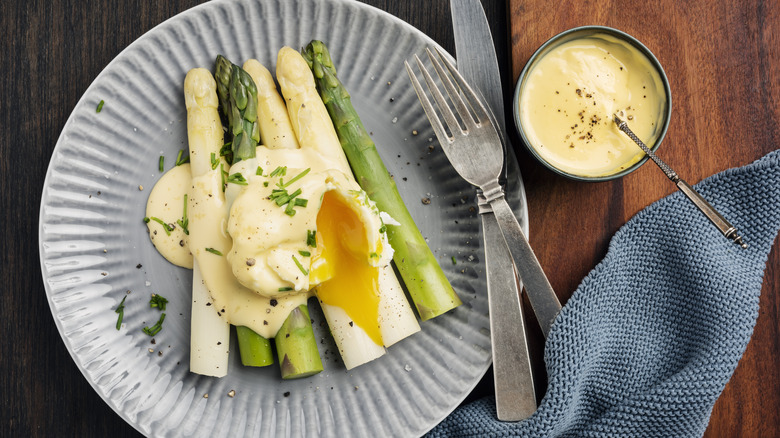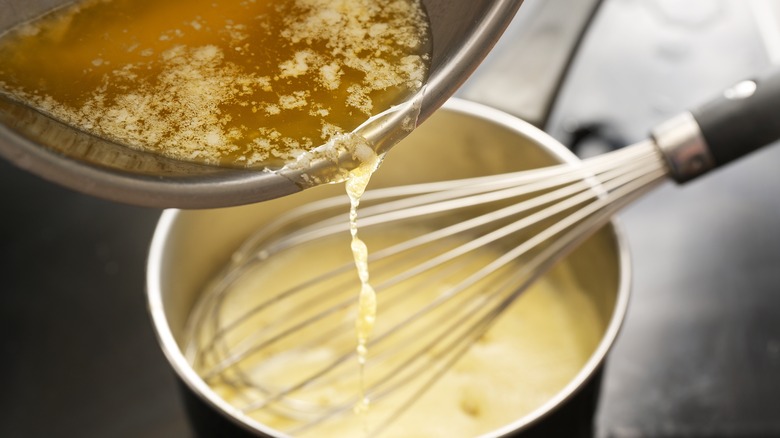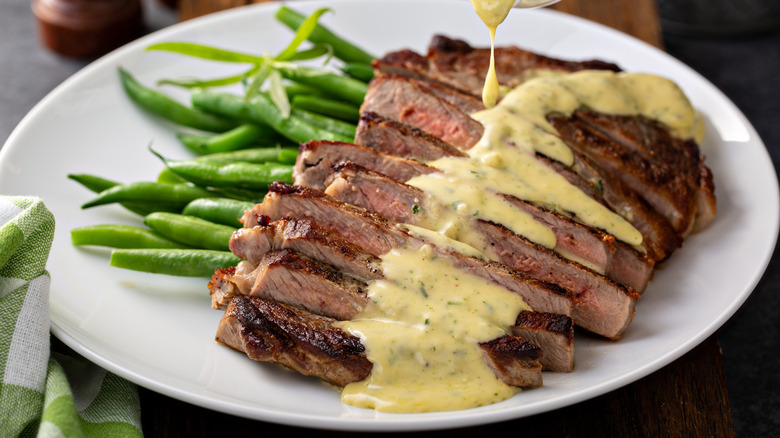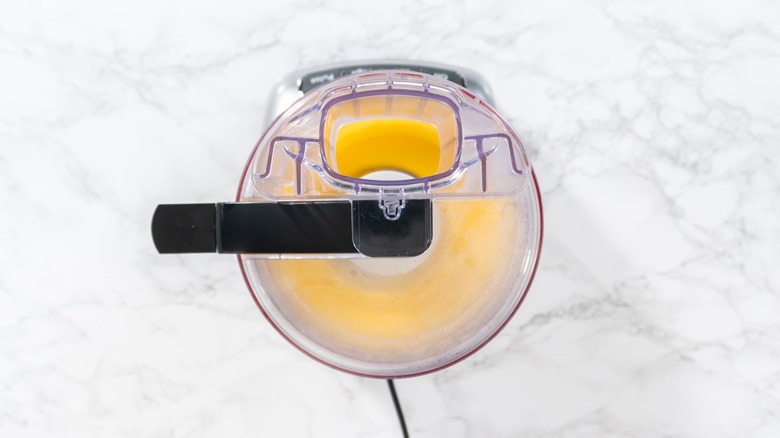No, Hollandaise And Bearnaise Sauce Are Not The Same
Hollandaise and béarnaise are delicious staples in French cuisine, and the similar appearances of these two luscious, pale yellow sauces makes them seem almost identical. Don't be fooled — while both are made from a base of butter and eggs, their flavors diverge from there, making them uniquely suited to different purposes.
Both of these sauces take patience and skill to whip up the traditional way. The ingredients must be whisked constantly as they cook over very low heat to create a smooth emulsion. A basic hollandaise sauce recipe includes just egg yolks, butter, lemon juice, and salt. Whisked egg yolks and water are delicately cooked in a double boiler, then melted butter is slowly poured in to create a creamy finish. Lemon, salt, and maybe a dash of cayenne or white pepper are mixed in at the end.
Béarnaise uses mostly the same technique, but with a more flavorful base. It gets a distinct tanginess from a wine vinegar reduction — which sometimes includes extra white wine — that has been infused with shallots, black pepper, and fresh herbs like tarragon or chervil. Lemon juice is sometimes added to make it extra bright and zippy. The shallots and herbs are strained out of the reduction and mixed with egg yolks before the mixture is cooked. The result is a creamy sauce with a punchier, more herbaceous flavor profile.
Béarnaise is a newer riff on hollandaise
The similarities between these two sauces is no coincidence. Hollandaise is one of the five French mother sauces, along with béchamel, velouté, espagnole, and tomate. These sauces are used in dishes on their own or as bases for countless variations, and béarnaise is essentially a spin-off of hollandaise.
Hollandaise translates to "from Holland," known presently as the Netherlands, but this buttery sauce originated in Normandy, France. It was formerly called sauce Isigny, after the town of Isigny-sur-Mer. There are a couple of different theories on the Netherlands connection. One possibility is that, due to shortages, France had to import butter from Holland during World War I. Another theory is that when persecuted Protestants fled France for Holland, and later came back, the newfangled sauce was brought over from the Dutch.
Hollandaise has been around since the 19th century, with an early iteration appearing in a cookbook in 1651. Béarnaise sauce is a much newer invention, created by Chef Collinet of the restaurant Le Pavillon Henri IV in 1836. It was likely named for the home region of King Henri IV: Béarn. Other hollandaise variants include maltaise (hollandaise plus blood orange juice and zest) and mousseline (hollandaise plus unsweetened whipped cream), but béarnaise has proven to be especially popular worldwide, especially in steakhouses.
When to use hollandaise versus béarnaise
Hollandaise and béarnaise can often be used interchangeably, but for some dishes, one sauce works better than the other. Both are among the best sauces and condiments for eggs, with hollandaise being famous worldwide as a topping for a traditional eggs Benedict recipe. They're also both delicious when poured over roasted vegetables. For most dishes, though, you should consider the flavor profiles of each sauce in order to create the most harmonious result.
Opt for hollandaise when you want to highlight the delicate flavors of more mild ingredients. The sauce is bright and rich, yet not overly assertive. Lightly-cooked vegetables and steamed or poached seafood will benefit from a generous spoonful. Blanched asparagus, silky filets of salmon, or artichoke hearts will also be delectable with a sheen of hollandaise, while their inherent flavors still sing loud and clear.
Béarnaise would be delicious with these same dishes, but this steakhouse classic can also stand up to heartier dishes. You should choose it over hollandaise when you want a little more boldness and depth. The acidity in béarnaise can complement not only a seared steak, but also a hearty piece of grilled white fish or some pan-roasted mushrooms. Using béarnaise in place of hollandaise can also jazz up the aforementioned eggs Benedict.
Quicker ways to hollandaise and béarnaise
Learning to make hollandaise and béarnaise the traditional way is worth the effort, but the whole double boiler technique can be intimidating. It requires a lot of stirring and babysitting, and the smallest slip-up can cause the eggs to scramble. If the classic method isn't within your skills as a cook, there are a few clever work-arounds that can save you time and produce more reliable results.
For example, this basic béarnaise sauce recipe calls for blitzing the egg yolks and acidic reduction in a blender or food processor, then slowly pouring in warm clarified butter while the blender is still running. You can use a similar technique by combining the ingredients in a sturdy jar, then mixing with an immersion blender instead. Hollandaise sauce can be made in these same ways, and you won't have to worry about accidentally cooking the eggs.
Another super simple hack relies on your microwave. For shortcut hollandaise, combine egg yolks, melted butter, lemon juice, and the non-traditional addition of half-and-half or cream. Then, microwave in short bursts — stirring between each interval — until it reaches the right thickness. To make it béarnaise-ish, add some white wine vinegar and herbs to the mix. It's not the French way, but this trick is unbeatable for a lazy brunch or casual dinner that can use some fancying up.




